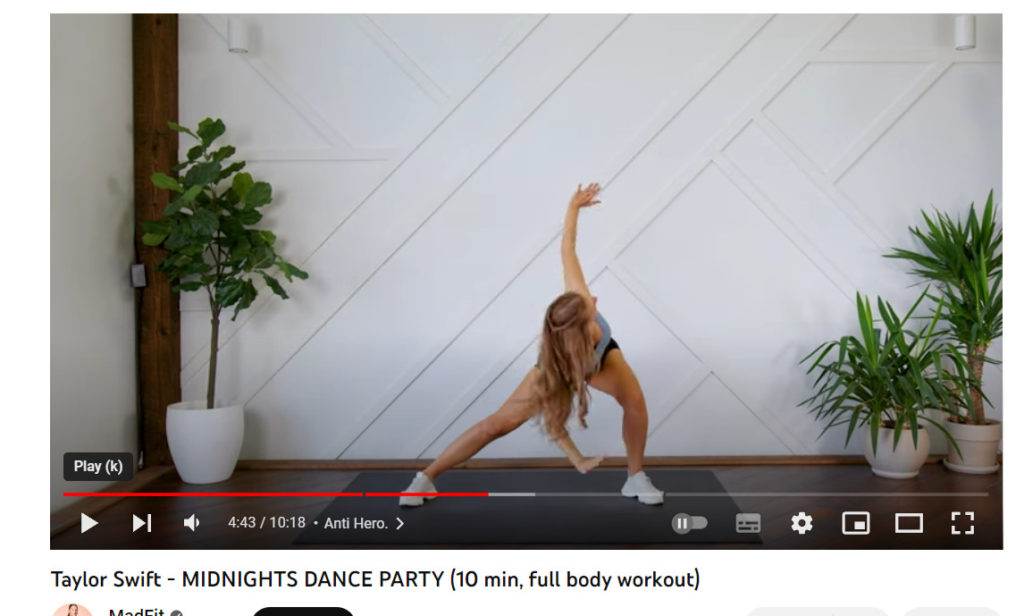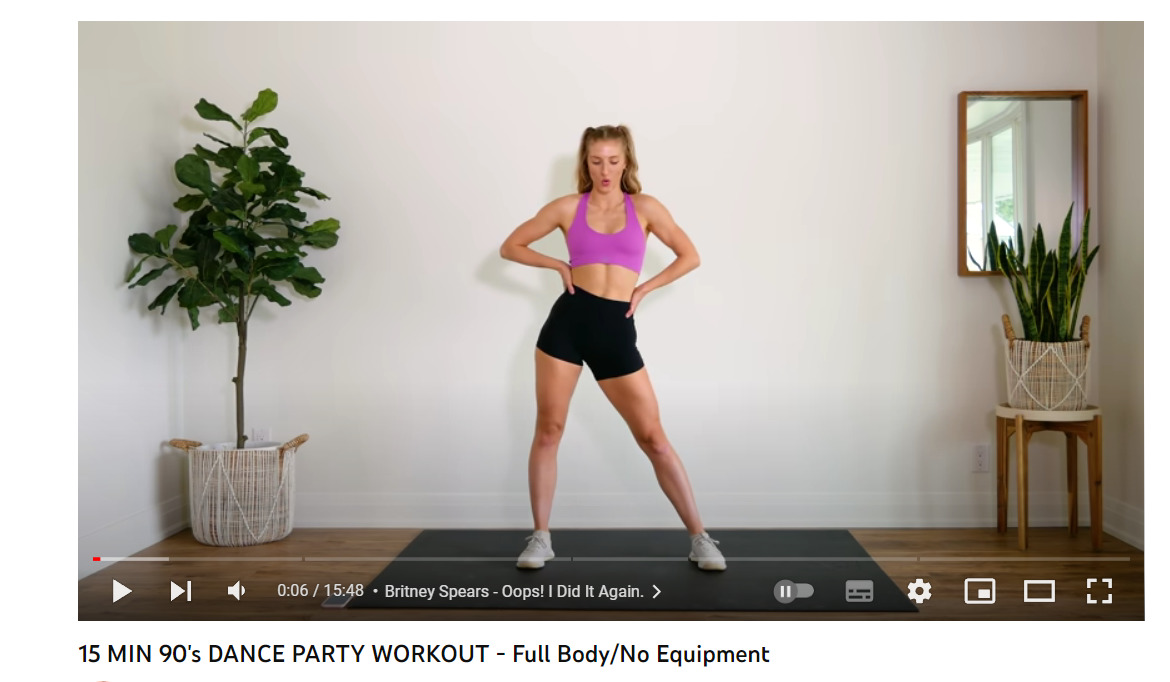Words by Elspeth Wilson. Elspeth took part in our Guest Writers development programme, supported by Arts Council England.
There is a level of exhaustion that my body experiences where I know that the only movement I will be able to do is dance. It’s a tiredness that feels like that furry feeling you get on your teeth when they’re too sugary, that comes from not leaving my flat often enough, from the pain of being inside on a sunny day, from having stayed up too late playing the Sims, from imagining what my life could be like in another universe. These tirednesses can only be fixed by dance.
And they can only be fixed by a dance that it is accessible in the right here, right now way. This need – which feels as urgent as the need to shower when you feel gross – is how I came to discover YouTube dance exercise videos in general and MadFit in particular. MadFit (a channel run by Canadian Maddie Lymburner which posts a range of different kinds of exercise videos) has almost 8 million subscribers. During lockdown, following these videos became a way to at once escape and situate myself in my body. Still now, if I’m having a bad day and know I won’t be able to do another form of movement, sweating in my pyjamas as I attempt to follow ‘One Direction dance party workout’ is how I come back to myself. This kind of everyday, domestic dance is how I make my body a home.
***
In the first lockdown, when I was flinging myself about my room to the sounds of 80s hits, my friend started filming dances with her family on TikTok. She posted one or two on her private Instagram account and I found them light and fun during a difficult time and gave them a casual like. It wasn’t until several years later that I spoke to her more about her TikTok dances and realised just how into it she was. She told me that she’d tried to learn various routines that were popular at the time when she’d been isolating with her parents. I could tell from her face that the dances had bought her happiness and movement when she was otherwise restricted, but also that she was uncomfortable talking about it.
“It’s the most embarrassing thing I’ve done in my life,” she told me. “No one can see them.” I protested and reassured, telling her about my crap dancing in a birthday video that was once posted on Facebook for a friend. Eventually, she agreed to tell me the name of her account if I didn’t tell anyone else. I promised. Later at home, I watched my friend dance with vitality and confidence and the occasional misstep, looking beautiful, joyous and happy.
A few months later, I see some thirteen year-olds filming their TikTok video on the front seats of the bus. My first instinct is to cough until I catch myself. The giggles and hilarity ensuing from their dance are infectious and blow away my snobbishness.
***

When I was younger, I danced all the time, both in shows I put on myself for my long-suffering parents and also on stage through local youth theatre and dance companies. As I became a teenager, self-consciousness set in as I realised I didn’t have the kind of body deemed ‘right’ for dance – I was too big, too tall, too booby. Later, when the pain came, it felt like I was further away from dance than I had ever been. I didn’t even dance on nights out anymore and I ached for those pure moments of abandon.
The (return) path to dance is meandering, often surprising and all too common after previous misdirection.
***
For most people, the kind of dance that we think of as being a part of ‘culture’ is a separable, sophisticated thing that plays little to no part in their daily lives. Most people do not do or watch ballet, most people do not go and see dance in prescribed locations at prescribed times, or attend any kind of formalised dance class. But a lot of people do engage in exercise videos. And a lot of people do watch Tiktok. And people do dance – they move their bodies, they have fun, whether it’s for camera or whether it’s at an old friend’s wedding or whether it’s after sugary alcopops in a dark club at 3am.
What does it mean when we don’t talk about this? What does it mean when billions of bodies are lying in the blank spaces on the page when we talk about dance?
***
Dance is something I do badly but I enjoy it. As a professional writer, I’ve found it crucial to have creativity in my life that is not in service of individual betterment or financial gain. If anything, pursuing (a kind of) art in a professional capacity has made me feel more strongly about the need to promote and preserve access to art as something fun, silly, and playful.
Gillie Kleiman, who wrote a score called friend, which is specifically for non-professional dancers, discusses what can be lost in the process of professionalising one’s passion when she talks about her love for dance as a teenager; “Up until this point I had probably seen no more than 10 professional performances (and lots of youth and community performances), so I didn’t know to what I was relating, and it didn’t occur to me to care. I just wanted to do it. It was fun.” In the same blogpost which reflects on the delight of making art outside your professional artform, Kleiman goes on to say “Making art is fantastic. But ‘being an artist’ has so many drawbacks.”
Of course, there should be far greater accessibility for professional dancers but something is lost when we don’t widen our idea of accessibility to also think about the non-professional. The division between ‘high’ and ‘low’ culture itself is inaccessible – it says that the kind of dance that I do, the kind of dance that millions of people watch every day is somehow worse. The subtext is that this kind of accessibility is not something to be celebrated – that only some bodies should dance and for those bodies that are deemed worthy, they should only dance in certain ways at certain times.
Perhaps the worst part about TikTok is that at the same time as making dance fun, public and (widely) watchable, it also potentially professionalises dance for all of us. In giving everybody the ability to go viral, there is always the chance – however slim – that one could become a TikTok star and thus monetise one’s dancing. Whilst there should be far greater rights and better payment for arts workers, as well as more transparent routes for working in dance for those who want to, there should also be more routes to dance in general for anyone and everyone. I feel like we don’t talk about that enough – the joy of doing things badly, the irreverence and sheer fun of dancing for and with your body, no matter what it looks like.
***
My body – with its pain, its clumsiness, its lack of coordination, and its sporadic mobility problems – feels like one that is destined to be designated as ‘audience’ in the dance world. It feels like its job is to react in the appropriate fashion, to watch, to gasp, to laugh (but only in the right places), to observe. This was the role I performed, obediently and well, for so many years. YouTube reminded me that I can be both that and something else, or even both at the same time. Audiences don’t have to be static or versus. They don’t even have to exist at all.
***
My bodies dances with capitalism. It dances with capitalism when I watch MadFit and I have to pause when the ad breaks come on because YouTube constantly finds ways to dodge my adblocker. Your body dances with capitalism too, whether you just move it a certain way to swerve round closing train doors or whether you’re a professional dancer who dances for a company that is sponsored by other (commercial) companies or otherwise has to engage in capitalist models of funding and revenue.
TikTok and YouTube might be obvious in their capitalism and the way they exist to mine your attention and data. Evidently, we need to critique the huge problems inherent in these data giants and the way they strive to make having a good time with friends into a performance of conviviality for an audience. But this doesn’t mean that we should discount forms of dance that can be viral in their sense of camaraderie and fun, as well as algorithmically.
On social media, I’ve seen more kinds of bodies dance than I’ve ever seen before, and irreverence and playfulness that I haven’t experienced since I was a child. We just need to dream bigger. I want to live in a world where we can dance on the bus or at home or wherever, for ourselves or for friends or whoever, with whatever body and range of movement is available to us at the time. Where my friend could be proud of her TikTok dance videos and not have to hide behind a deluge of ‘it was only for fun’s. I want all that and not just for an app or for likes. But perhaps we have to accept that the proliferation of social media has showed us the very beginnings of what a more liberated (dance) world could look like.
There should be so many chances to dance in life. My body will looking for them when nothing else will do. I’ll be dancing to Taylor Swift on my own late at night in my room. I’ll be doing MadFit videos and whirling round and round when the ads are playing so that the rush of my own blood in my ears blocks out the sounds of someone trying to sell me something. I’ll know that when I need a chance to escape in a way that looks to different possible futures, I’ll always be able to return to the highs of ‘90s throwback dance party’.
